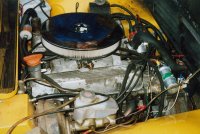Rover V8 section
Well there it sat in the engine bay, looking a bit rusty (I hadn't bothered to have it re-chromed - I was going to drive the thing, not look at it), a bit lonely (I had yet to fit the exhaust manifolds and air filter) and a bit bodged (the coil was mounted on an old piece of wood and I was sure I could see the imprint of a frustrated hammer blow!).But it did look menacing. 8 cylinders of burble, growl and torque just innocently nestled in the bay. All it needed now was some life in it, so I set about hooking up all the wiring - making especially sure that there were at least two good thick earth leads. Re-wiring was actually fairly simple - the Haynes manual was fine and, coupled with the wiring diagram from the Lotus service notes, it all took shape. If you think about it, most of the wiring stays static - it's just the engine bits that need a bit of thought.
Ignition
You can keep the original V8 ignition system if you want, but (especially if it's the old OPUS type), you'll do as well to change it. I did 'phone a dealer to ask for some advice and he professed amazement that someone had actually found a working OPUS distributor! After some advice from Chris Crane at RPi (he also laughed at my OPUS!) I bought a Mallory dual point ignition system and matching coil. It's relatively simple to fit, but for anyone needing a diagram (albeit with only 4 spark plugs shown!!), there's one here. My one main piece of advice is to be careful of the permanent 12V feed that the Lotus ignition uses. The Rover ignition doesn't work that way, so don't try to connect a permanent 12V feed to the Malory, or you'll cook something!
Exhaust System
Before I fitted the exhausts I was extremely irresponsible, inconsiderate to my neighbours, and probably burned a small hole in the ozone layer. However my neighbours would get over it (and stuff the ozone layer), I really wanted to know what the engine sounded like bare. I put the key in the ignition, turned it and gently pushed the accelerator.
Nothing.
I tried again, this time with bit more throttle and the carburettor coughed, a wisp of smoke emanated from one of the exhaust outlets, and the engine spluttered.
At the third time of asking, I didn't know whether the garage had collapsed or the house had somehow become a homing beacon for stray ballistic missiles, but I suddenly felt like I'd lost bowel control and a herd of elephants was stampeding through my chest. My ears hurt, my eyes bulged and I couldn't stop my teeth from chattering. Then I turned the engine off again and, while my ears sang and my digestive system began to take stock of what on earth had just happened, I decided that it was perhaps advisable to fit the exhausts after all.
Although the Elite/Eclat bay was originally intended to accommodate a V8, there is surprisingly little room for the exhausts once the engine has gone in. You CAN'T use the original Rover exhaust manifolds (even though they apparently weren't that bad) as they foul on the frame. I looked into all sorts of exhaust system options - even looked at having one especially made and balanced - but I struck gold at the MGB Hive. They do MGB stuff, and MGBs have also been known to house V8 engines. Being such weeny cars, the exhaust sytems need to be compact, which is where MGB Hive helped - they make block huggers that snake down and under the engine and then away to the rear. The guys at MGB Hive were really helpful when I explained what I was doing and they sent me a 5 piece stainless block hugging system for 200 quid. Excellent value. Once that was installed, it was relatively simple to connect to the original Lotus exhaust sytem; you can get a complete system if you wish, but I preferred the retain the two Lotus tail pipes that make it all look nice and balanced.
Starting the car this time was a lot more civilised and I was pleasantly surprised to discover that only a couple of very small exhaust leaks had presented themselves. I was also concerned by a rhymical 'clunk-thud-clunk-thud' that came from under the car. It wasn't the engine - it was too far back - but it was definitely a worrying noise. I stopped the engine, re-started it and there it was again. I thought a bit and, when I realised that there was nothing obvious to 'fix' with hammer, got quite worried. There was nothing fouling under the car, I'd connected all the engine correctly - what on earth had I done? It was then that I spotted four bolts on the floor near the rear wheels.
Ah - perhaps I ought to connect the prop shaft to the diff....

Back to Top | Back to restoration index | Page 1 | Page 7 | Page 9